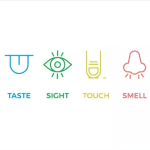
Marketing experts have long made use of insights from psychologists to draw conclusions about consumer purchasing habits. As the first point of contact between customer and product, packaging has a crucial part to play.
High-quality products come with high-quality packaging – in simple terms, that is the expectation of many consumers. How this quality is conveyed, however, is a different matter entirely. After all, decisions are not always deliberate: the packaging and its shape can also convey feelings that we pick up subconsciously. Marketing experts group these factors together under the heading of multisensory features. These include optics, texture, and olfactory sensory impressions – smell and touch, in other words. Now, thanks to Augmented Reality and the opportunity it provides to convey additional features via mobile terminals, digitalization adds another way of appealing to the senses.
Incorporating all these points means it is not easy for manufacturers to choose the right packaging. Ultimately, there must be no impact on cost-effectiveness and functionality. And, of course, sustainability cannot be ignored. These subjective and objective influences are what packaging designers try to steer in the direction they want through the use of colour, shape and texture.
Obvious and yet subtle: optics count
Colour is the most important feature among the many visual clues that consumers pick up. It influences their buying habits and generates attention. This is where psychological insights regarding colour perception come in, and they are put to deliberate use (red as a warning colour, blue for freshness, etc.). This signalling function can differ between cultures, however, which must be considered in the case of products marketed globally.
Shape is another optical impression that facilitates recognition, is an important design element, and often constitutes a unique selling point for particular products. Packaging shape is therefore part of a product’s visual language. In other words, the shape is associated with a particular product category or brand.
The technical capabilities of the filling and packaging process often restrict the choice of shape: can the packaging facility produce the design efficiently? Automation and increasingly versatile robots are steadily redefining these limits, as machine manufacturers demonstrated once again at FachPack 2019. Here, too, it is optics that make new technological advances possible, including image recognition systems for robots, which can accurately pick up, put down and pack a range of product shapes, thus helping to automate the entire process.
Perception via the hands: tactile impressions
Perception in the broader sense brings another packaging refinement option into play: product packaging with an interesting and distinctive feel or finish can serve as an effective marketing tool. This may involve the use of coatings or embossing, for example. High gloss and smooth surfaces are often considered as quality features. At the FachPack special show on “Premium Packaging”, exhibiting companies showed how shape plays a crucial part in establishing a successful brand presence.
But companies that value sustainable packaging materials can also turn the different feel of their packaging materials to their advantage: consumers often associate more sustainable products with rougher surfaces and paper. Here, too, the thickness of the sheets or the relationship between the effort that has gone into the packaging and the content play an important role.
Hearing and smelling: subconscious, but all the more important messages
To accommodate all the senses in the purchasing experience, packaging designers are well advised to give some thought to sounds and smells. The sound the packaging makes when a product is taken down from the shelf or is opened creates a connection with a particular article and its quality for many consumers. Of course, a packet of crisps has to rustle, and a “pop” shows that a drink bottle was still unopened, and even metal cans make distinctive sounds when they are opened. If not before, we will remember the lasting impressions made when tearing open and unwrapping parcels when Christmas arrives. Christmas has another “secret tip” to offer for marketing: smells. They can also influence our purchasing decisions.
Even so, it is not easy to convey smells via packaged products. One of the most important functions of packaging is to isolate the contents from the outside world. Fundamentally, negative smells should be banned from all packaging – glue smells or plastic components that leach out leave behind a negative “aftertaste” and must be avoided from the outset.
Coffee is one example of how manufacturers manage to appeal to the sense of smell despite tight packaging. The incorporation of “scent valves” enables the smell to reach the outside without letting any air in. And ultimately, what applies in real life also goes for packaging: the first impression counts.


